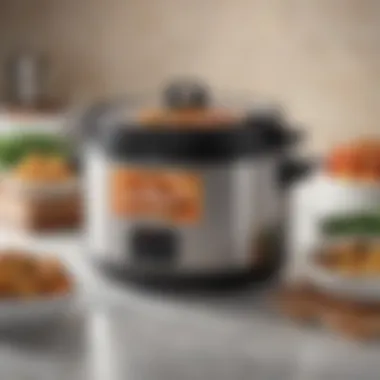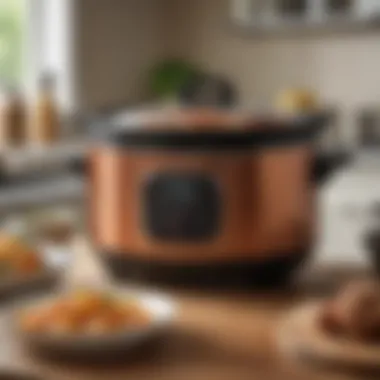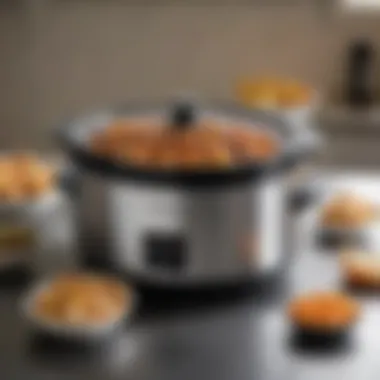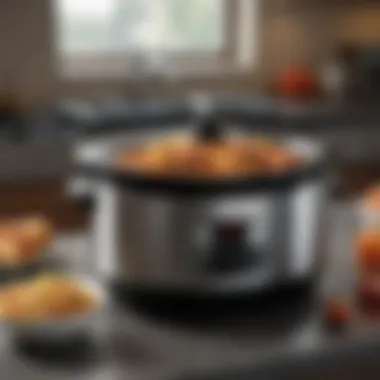Exploring the Versatility of a 1.5 Quart Slow Cooker


Intro
The 1.5 quart slow cooker is an often overlooked kitchen appliance, yet it holds great potential for home cooks and culinary enthusiasts alike. This compact size is ideal for single servings or small family meals, offering numerous possibilities. The convenience of slow cooking allows flavors to fully develop while requiring minimal active kitchen time. In this guide, we will explore the versatility of the 1.5 quart slow cooker, addressing everything from its uses to maintenance. Our discussion will revolve around various recipes, key ingredients, and effective cooking tips.
By understanding how the 1.5 quart slow cooker fits into modern culinary practices, one can better appreciate its role in both traditional and contemporary cooking environments. This exploration aims to equip both novice and experienced cooks with the knowledge to maximize their culinary endeavors.
Understanding the 1. Quart Slow Cooker
Understanding the 1.5 quart slow cooker is essential for those interested in efficient and convenient cooking methods. This appliance is designed to cater to the needs of individuals or small families. It provides flexibility in meal preparation, particularly for those who may not require the higher capacities of larger slow cookers.
Notably, the 1.5 quart size makes it easier to manage portion sizes, which is increasingly relevant in today's health-conscious environment. This smaller model allows for controlled serving sizes without encouraging waste. Also, those living alone or in smaller households find value in its compact size, enabling them to prepare meals that are easy to store and consume.
Defining the Appliance
A 1.5 quart slow cooker is a compact kitchen appliance which often provides several functionalities. It primarily uses low and slow cooking techniques, allowing ingredients to meld together over extended periods. This method enhances flavors, making meals more enjoyable and significantly easier to prepare. The simplicity of its operation appeals to both novices and experienced cooks, making it a staple in many kitchens.
Key Features
Size and Capacity
The capacity of a 1.5 quart slow cooker is one of its most appealing traits. This size is particularly suitable for cooking one-pot meals, side dishes, or soups. A main characteristic of its size is that it is not overwhelming in the kitchen space. This space-efficient design allows users to place it on kitchen counters without consuming excessive area. Additionally, the smaller capacity is beneficial for meal prep, as it encourages the preparation of smaller batches conducive to various dietary plans. Yet, the limitation in capacity can also restrict the variety of dishes one can prepare simultaneously.
Temperature Settings
Temperature settings are another defining aspect of the 1.5 quart slow cooker. Most models offer low, medium, and high settings. This versatility enhances cooking options, allowing users to select the appropriate temperature for specific dishes. A prominent feature of adjustable temperature settings is their ability to maintain consistent heat over long periods. This results in tender dishes, especially when cooking tougher cuts of meat. While the flexibility in temperature provides options, some users may find that mastering the timings for different recipes can take practice.
Design and Construction
The design and construction of a 1.5 quart slow cooker usually combine practicality with style. Most models are designed with a sturdy base and a removable insert for easy cleaning. The snug lid helps retain moisture and heat, contributing to effective cooking. A unique aspect here is the use of materials that promote even heating, preventing hot spots. This design caters well to users who prioritize functionality. However, plastic components can pose challenges during cleaning if not cared for properly, necessitating more meticulous maintenance.
Advantages of Using a Slow Cooker
The advantages of a slow cooker are numerous, making it a valuable addition to any kitchen. These appliances offer practicality, convenience, and even health benefits, which all contribute to their growing popularity among home cooks. The slow-cooking process allows for better meal preparation and creates a welcoming environment for diverse, flavorful dishes. This section will explore the practical elements that make slow cookers like the 1.5 quart model so appealing.
Efficiency in Cooking
Set-and-Forget Convenience
Set-and-forget convenience is perhaps the most recognized feature of a slow cooker. This characteristic allows you to prepare a meal without constant supervision. You can place your ingredients inside, adjust the settings, and go about your day. This not only saves time but also alleviates the stress of being in the kitchen constantly. Busy individuals find this especially appealing as it fits well with their schedules. The unique feature of this convenience is its ability to blend multiple components into a single meal effortlessly. This makes the 1.5 quart slow cooker a helpful tool for any culinary enthusiast.
Energy Consumption
Energy consumption is another factor that highlights the advantages of slow cooking. Compared to conventional cooking methods, slow cookers generally use less electricity. This is particularly beneficial for those conscious of energy costs. The lower energy usage means that the appliance can operate for long durations without a significant increase in energy bills. However, it is essential to note that overloading the slow cooker can lead to inefficient cooking and might negate some of the energy benefits. Hence, it’s crucial to follow recommended ingredient and liquid levels.
Flavor Enhancement
Infusing Herbs and Spices
Infusing herbs and spices is a specific aspect of flavor enhancement that slow cookers excel at. When cooking over several hours, flavors have more time to meld and intensify. Using slow cookers enables cooks to utilize a wide array of herbs and spices without overwhelming the dish. The unique feature of this technique lies in the gradual cooking, which extracts essential oils from herbs and spices, creating deeper flavors. However, it requires some practice to know the right quantities to achieve ideal flavor profiles.
Breaking Down Tough Ingredients
Another benefit of using a slow cooker is its ability to break down tough ingredients. Ingredients like tougher cuts of meat or fibrous vegetables become tender through long cooking times. This method is advantageous for creating hearty dishes like stews or braised meats. One unique aspect of this is that slow cooking requires lower temperatures, allowing the food to soften slowly without drying out. A downside is that trying to rush the cooking process will not yield the same results, thus requiring patience.
Health Benefits


Slow Cooking Nutrients
Slow cooking preserves nutrients effectively, which is a significant health benefit. Cooking at lower temperatures and for extended periods minimizes nutrient loss in the food. This preservation means that the meals prepared in a slow cooker can be both flavorful and nutritious. Notably, many people find that vegetables retain their vibrant colors and flavors. However, some nutrients may become less bioavailable after prolonged cooking, requiring careful selection of cooking times and temperatures.
Reduced Need for Added Fats
Using a slow cooker also reduces the need for added fats in meals. This aspect can be particularly beneficial for those aiming to maintain healthy diets. The slow cooking process helps to tenderize foods naturally, making additional fatty ingredients less necessary. The unique feature here is that moisture is locked in during cooking, allowing flavors to develop without the need for excessive oils or fats. Yet, cooks must find the balance to ensure flavors do not suffer from lack of added fats.
Choosing Recipes for a 1. Quart Slow Cooker
Choosing recipes specifically for a 1.5 quart slow cooker allows for thoughtful meal planning and efficient cooking. This section will discuss the significance of portion control and appropriate dish selection, tailoring meals for the capabilities of this compact appliance. Understanding how to maximize the use of limited space can enhance the cooking experience and help to avoid common pitfalls when preparing food in smaller quantities.
Portions and Serving Sizes
Meal Types for Small Batches
When considering meal types suitable for a 1.5 quart slow cooker, small batches are an essential focus. Small batch meals can efficiently serve individuals or small families while minimizing waste. This characteristic makes it a popular choice among people who prefer cooking less at a time.
Typically, meals like chili, or even oatmeal can be cooked to perfection in this size cooker. One important advantage of small batches is that they require less cooking time and can be prepared with fewer ingredients, which often leads to simpler recipes and easier cleanup.
Adjusting Standard Recipes
Another crucial element is the adjustment of standard recipes to fit this smaller cooker. Not all recipes are instantly adaptable for a 1.5 quart slow cooker. Reducing serving sizes and modifying ingredient quantities can help. This allows you to experiment and create your own twist on classic dishes.
A key characteristic of adjusting standard recipes involves careful thought about ingredient proportions. Notably, this requires a good understanding of the original cooking times and adapting them according to how much smaller the batch is. This adaptability makes it relatively easy to create satisfying meals without consuming too much time or energy.
Types of Dishes
Soups and Stews
Soups and stews are among the most popular types of dishes that one can prepare in a 1.5 quart slow cooker. These kinds of meals not only leverage the slow cooking method to enhance flavors, but they also align perfectly with the size of the appliance.
The key characteristic of soups and stews is their ability to combine various ingredients, allowing for aromatic blends and hearty results. The unique feature here is how slowly simmering can break down ingredients like beans or tough cuts of meat. However, a disadvantage may arise if the recipe calls for too many components, leading to overflow.
Desserts
Desserts offer another intriguing option for the 1.5 quart slow cooker. They bring an unexpected versatility to the appliance. Types of desserts such as puddings or cake can be created without the complexity often involved in traditional baking.
The nature of slow cooker desserts allows for consistent heat distribution, creating moist and rich results. However, one downside is that not all desserts translate well into slow cooker format, which may require experimentation before finding the right combinations.
Meat Preparations
Lastly, meat preparations are a significant addition to the possibilities that a 1.5 quart slow cooker holds. The appliance excels in tenderizing meats through low and slow cooking. This is particularly advantageous for tougher cuts that benefit from extended cooking times.
The unique feature of meat dishes is the infusion of flavors from spices and marinades, transforming simple ingredients into savory meals. Nonetheless, the challenge lies in selecting the right portion sizes, as improperly adjusting may lead to dry or unfulfilling results.
This section of the article aims to highlight how selecting the right recipes can optimize the utility of a 1.5 quart slow cooker. Being mindful about serving sizes, and adapting traditional recipes contributes to a more satisfying cooking experience.
Practical Tips for Cooking
The 1.5 quart slow cooker offers unique advantages, particularly for individuals or small households. Practical tips can greatly enhance your cooking experience. Proper use of this kitchen appliance can lead to rich flavors and satisfying meals. Moreover, using the right techniques can ensure that you maximize the benefits of slow cooking while minimizing potential drawbacks.
Ingredient Preparation
Chopping and Slicing Techniques


Chopping and slicing ingredients is a fundamental step in slow cooking. This task ensures that your ingredients cook uniformly and absorb flavors effectively. A key characteristic of chopping is the consistency it brings. Uniformly chopped vegetables can lead to even cooking, preventing some from becoming overcooked while others are still hard. This technique is beneficial as it allows for better flavor integration in the final dish. A unique aspect of chopping includes the choice of knife; using a sharp chef's knife helps make clean cuts that retain the integrity of the food. In contrast, using dull knives may result in uneven pieces and unwanted juices. This could impact the final taste and presentation.
Layering for Optimal Flavor
Layering ingredients in a slow cooker is an essential technique for maximizing flavor. Proper layering leads to better infusing of flavors from the aromatic herbs and spices into the dish. A key characteristic of layering is the use of density; heavier items like potatoes should be placed on the bottom, while lighter ingredients like herbs can go on top. This method is popular among experienced cooks for creating depth in flavor. A unique feature of this technique is its role in moisture retention. Ingredients on the top prevent evaporation, allowing those at the bottom to absorb more flavors. However, if not done well, it could lead to some elements cooking too quickly, especially delicate ingredients, so care must be taken.
Cooking Time Management
Managing cooking time is crucial when working with a slow cooker to achieve the best results. Knowing how different ingredients cook can influence the final dish's quality and flavor. Time management requires familiarity with cooking times for various items, as some may take longer to become tender.
Determining Time Based on Ingredients
Determining cooking time based on the ingredients is an important aspect of slow cooking. Each ingredient has a unique time frame for becoming tender. For example, root vegetables take longer to cook than leafy greens. A notable characteristic of this technique is the need to plan ahead; understanding when to add certain items can lead to a successful dish. This method is particularly advantageous because it allows for flexibility in using what is available. However, if miscalculations arise regarding times, it can lead to overcooked or undercooked ingredients, diminishing the overall taste.
Adjusting for Altitude and Climate
Adjusting cooking times based on altitude and climate is often an overlooked factor in slow cooking. At higher altitudes, water boils at lower temperatures, which affects cooking times and moisture retention. This adds complexity to the process. A key characteristic of this adjustment is awareness; knowing how your environment impacts cooking can significantly alter results. It is beneficial as it ensures that even when conditions change, the final dish meets expectations. However, these adjustments may be challenging for inexperienced cooks, requiring additional research or experimentation.
Understanding these practical cooking tips can greatly enhance the use of your 1.5 quart slow cooker. Cooking wisely, especially in preparation and time management, leads to exceptional results.
Maintaining Your Slow Cooker
Maintaining your slow cooker is crucial for ensuring longevity and optimal performance. Regular upkeep not only enhances your cooking experience but also ensures that your meals consistently meet high standards. A well-maintained slow cooker can help you avoid common pitfalls, ensuring a safe and efficient cooking process. This section provides an overview of essential maintenance tasks that every owner should consider.
Cleaning and Care Guidelines
Cleaning is a fundamental aspect of slow cooker maintenance. It ensures that flavors remain intact and prevents cross-contamination. Any leftover food residues can negatively affect future dishes.
Cleaning the Insert
Cleaning the insert is often the most critical part of maintaining your slow cooker. The insert is usually made of ceramic or non-stick material, allowing for easy cleaning.
- Key Characteristic: Many inserts are dishwasher safe, making cleanup straightforward.
- Unique Feature: Non-stick surfaces reduce the likelihood of food sticking, aiding easy removal of ingredients post-cooking. However, some users may find that ceramic inserts can chip over time if not handled with care.
- Advantages: Using appropriate cleaning techniques preserves the insert’s quality, which directly impacts cooking performance.
To clean the insert, allow it to cool down, rinse off residue, and use a soft sponge or cloth with soapy water. Avoid metal scrubbers which may scratch the surface.
Maintaining Exterior and Electrical Components
Taking care of the slow cooker's exterior and electrical components is equally important. Regular checks can prevent further issues that may disrupt functionality.
- Key Characteristic: Keeping the exterior clean helps maintain aesthetics as well as safety during usage.
- Unique Feature: Regularly inspecting the power cord can catch frayed wires that pose a safety threat.
- Advantages: A clean outer surface minimizes dust buildup, ensuring that ventilation remains effective and heat control is maintained.
Wipe down the exterior with a damp cloth periodically. Always check for any signs of wear on electrical components to address any issues before they escalate.
Troubleshooting Common Issues
Even with regular maintenance, problems can arise. Understanding common issues helps in resolving them quickly.
Electrical Malfunctions
Electrical malfunctions can disrupt cooking and even lead to safety hazards.
- Key Characteristic: These malfunctions can manifest as the slow cooker not turning on or inconsistent heating.
- Unique Feature: Electrical problems often relate to a faulty connection, be it in the plug or internal wiring.
- Advantages: Identifying these issues early can prevent costly repairs or replacements.
If the cooker does not power up, try a different outlet or check for tripped circuits. If issues persist, seeking professional repair might be necessary.


Unwanted Odors or Residues
Unwanted odors can be a nuisance after cooking, affecting the taste of future meals.
- Key Characteristic: These odors often arise from burnt food residue or improperly cleaned inserts.
- Unique Feature: Odors can linger, making it important to address any cleaning shortcomings directly after use.
- Advantages: Consistent attention to cleaning can prevent unpleasant smells and ensure your slow cooker is ready for the next dish.
To combat odors, regularly clean the insert and consider using natural deodorizers, like baking soda, in the insert before a wash.
By being diligent with maintenance and addressing problems promptly, you will enhance the performance and safety of your 1.5 quart slow cooker, ensuring it remains a valuable tool in your kitchen.
Exploring Global Recipes
The versatility of a 1.5 quart slow cooker is vividly showcased through its ability to adapt to various global cuisines. This section highlights how different culinary traditions can be successfully integrated into your slow cooking experience, offering a delightful array of flavors. Exploring global recipes not only enhances the cooking repertoire but also encourages experimentation with ingredients and techniques that may be new to home cooks. Each cuisine brings with it a unique set of characteristics, which can elevate the everyday use of your slow cooker.
Cuisines to Consider
Italian Flavors
Italian cuisine is known for its rich flavors and simple yet high-quality ingredients. Recipes such as stew and risotto benefit from the slow cooker's low and steady heat. One of the key characteristics of Italian flavors is the usage of fresh herbs, like basil and oregano, which infuse a subtle aroma when cooked gradually. Italian dishes also allow for flexibility, enabling you to adjust ingredients based on available produce. The use of local tomatoes for a marinara sauce or seasonal vegetables can make dishes taste authentic. Overall, Italian recipes provide a beneficial option for a slow cooker due to their ability to develop richer flavors over time.
Mexican Inspirations
Mexican cuisine introduces a bold array of spices and flavor profiles. Often, dishes such as chili con carne and enchiladas fill the slow cooker with vibrant aromas. The key characteristic here is the powerful combination of chilies, cumin, and garlic. These ingredients meld beautifully during slow cooking, enhancing the overall taste. One unique feature of Mexican recipes in the slow cooker is the capacity to lessen cooking time for tough cuts of meat, making them tender while absorbing all the requisite spices. This method is highly advantageous for those seeking flavor without excessive effort.
Asian Delicacies
Asian cooking brings a diverse range of flavors. The possibility to create comforting dishes like curries and noodle soups elevates the slow cooking process. A predominant element in many Asian dishes is the balance of sweet, salty, and sour. Using ingredients such as soy sauce, ginger, and coconut milk, enables this balance to shine in your cooker. The gradual cooking allows these flavors to meld, producing a complex taste. However, one consideration is that overcooking can sometimes dull these fresh flavors, so careful timing is essential.
Authentic Dish Adaptations
Infusing Local Ingredients
Infusing local ingredients into international recipes enhances both authenticity and creativity in cooking. This approach allows cooks to personalize dishes, reflecting regional availability. A significant advantage of using local ingredients is the opportunity to support sustainable practices and minimize carbon footprint. For example, substituting imported spices with homegrown herbs can result in remarkable flavor without added costs. Yet, adapting recipes requires knowledge of the local ingredients’ unique taste profiles to ensure they harmonize with traditional flavors.
Adjusting Cooking Techniques
Adjusting cooking techniques can be an essential element when preparing global recipes in a slow cooker. Each cuisine has its standard practices, which might need modification for the slow cooking method. For instance, browning meat in a pan before adding it to the slow cooker can help develop depth in flavors. This foundational technique stands as an integral part of many Western and Asian recipes alike. Ensuring proper adjustments can lead dishes to retain their intended flavors and textures. Attention to timing and ingredient prep is crucial for achieving desired results.
End: The Role of the 1. Quart Slow Cooker in Modern Kitchens
In today's fast-paced world, where convenience is a priority for many home cooks, the 1.5 quart slow cooker has established itself as a valuable kitchen appliance. Its compact size positions it perfectly for small households or individuals, making it a practical choice for those who seek ease in their cooking. The versatility of this appliance allows for a wide range of recipes, from soups to desserts. This section underscores the significant role the slow cooker plays in modern culinary practices.
Slow cookers have evolved beyond basic recipes. With user-friendly features, they adapt to diverse cooking styles and cuisines. Often, people overlook their potential and limit their usage to traditional dishes. However, there are many possibilities. Recipes can be tailored for special dietary needs, including vegetarian and gluten-free options. With the increase in meal prepping, the 1.5 quart slow cooker has become a tool for health-conscious cooks eager to incorporate wholesome meals into their week.
"The beauty of a slow cooker is the ability to combine ingredients and allow them to develop richness over time."
Moreover, any cook can benefit from the efficiency offered by this kitchen appliance. Set-and-forget convenience aligns well with busy lifestyles. This means spending more time on other activities while ensuring a hot meal awaits when needed.
Final Thoughts on Utilization
Reflecting on the importance of utilizing a 1.5 quart slow cooker, it is vital to recognize its adaptability. It can accommodate a variety of cooking methods, such as braising or simmering. When considering meal preparation, this appliance allows you to explore different cuisines with minimal effort. Cooks can experiment with various ingredients, spices, and international flavors.
Utilizing the slow cooker efficiently means understanding portions and timing. It's essential to note that less is more. Overfilling can lead to uneven cooking and compromise taste. Focusing on manageable serving sizes ensures a delightful experience. Much like crafting a fine artistic piece, it requires precision.
Future Innovations in Slow Cooking
As technology continues to advance, the future of slow cooking appears promising. Innovations in cooking technology suggest we may see features such as app connectivity and programmable settings tailored to individual tastes. Imagine being able to control your slow cooker from your smartphone; adjusting settings from anywhere can truly redefine convenience in home cooking.
Additionally, development in smart appliances offers an opportunity for more integration. Some companies are already exploring ways to improve energy consumption, perhaps leading to appliances that are even more environmentally friendly.
Overall, the 1.5 quart slow cooker not only serves a purpose now but, with innovation, it holds the potential to integrate even more into the modern kitchen. As awareness grows regarding its advantages, enthusiasts will likely embrace its possibilities. The journey of slow cooking continues to evolve, aligning with the needs of contemporary culinary practices.







